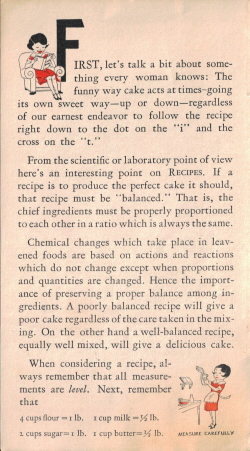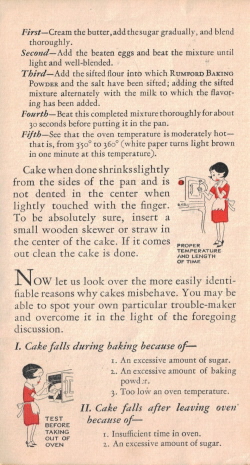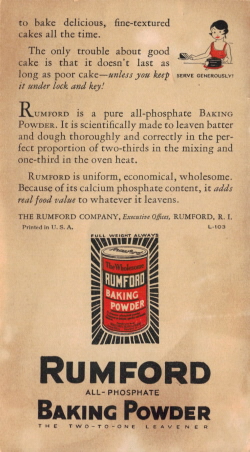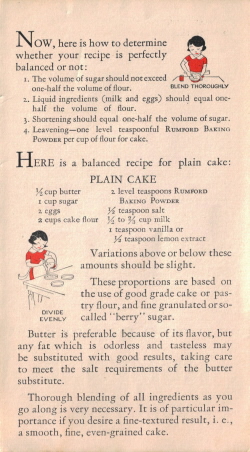 Here is a charming vintage pamphlet from Rumford Baking Powder that’s all about cakes–why they fail and what steps are needed to bake a perfect one every time. There’s also a recipe for a plain cake.
Here is a charming vintage pamphlet from Rumford Baking Powder that’s all about cakes–why they fail and what steps are needed to bake a perfect one every time. There’s also a recipe for a plain cake.
I don’t see a date but believe this was published sometime between the 1920’s and 1930’s.
I’ve typed the pamphlet below as well as scanned the entire copy, click to view larger images.
CAKE
GOOD
..BETTER
…BEST
which is yours?
FIRST, let’s talk a bit about something every woman knows: The funny way cake acts at times–going its own sweet way–up or down–regardless of our earnest endeavor to follow the recipe right down to the dot on the “i” and the cross on the “t.”
 From the scientific or laboratory point of view here’s an interesting point on RECIPES. If a recipe is to produce the perfect cake it should, that recipe must be “balanced.” That is, the chief ingredients must be properly proportioned to each other in a ratio which is always the same.
From the scientific or laboratory point of view here’s an interesting point on RECIPES. If a recipe is to produce the perfect cake it should, that recipe must be “balanced.” That is, the chief ingredients must be properly proportioned to each other in a ratio which is always the same.
Chemical changes which take place in leavened foods are based on actions and reactions which do not change except when proportions and quantities are changed. Hence the importance of preserving a proper balance among ingredients. A poorly balanced recipe will give a poor cake regardless of the care taken in the mixing. On the other hand a well-balanced recipe, equally well mixed, will give a delicious cake.
When considering a recipe, always remember that all measurements are level. Next, remember that
4 cups flour = 1 lb.
2 cups sugar = 1 lb.
1 cup milk = 1/2 lb.
1 cup butter= 1/2 lb.
NOW, here is how to determine whether your recipe is perfectly balanced or not:
- The volume of sugar should not exceed one-half the volume of flour.
- Liquid ingredients (milk and eggs) should equal one-half the volume of flour.
- Shortening should equal one-half the volume of sugar.
- Leavening–one level teaspoonful RUMFORD BAKING POWDER per cup of flour for cake.
HERE is a balanced recipe for plain cake:
PLAIN CAKE
1/2 cup butter
1 cup sugar
2 eggs
2 cups cake flour
2 level teaspoons RUMFORD BAKING POWDER
1/2 teaspoon salt
1/2 to 2/3 cup milk
1 teaspoon vanilla or
1/2 teaspoon lemon extract
Variations above or below these amounts should be slight.
These proportions are based on the use of good grade cake or pastry flour, and fine granulated or so-called “berry” sugar.
Butter is preferable because of its flavor, but any fat which is odorless and tasteless may be substituted with good results, taking care to meet the salt requirements of the butter substitute.
Thorough blending of all ingredients as you go along is very necessary. It is of particular importance if you desire a fine-textured result, i.e., a smooth, fine, even-grained cake.
 First–Cream the butter, add the sugar gradually, and blend thoroughly.
First–Cream the butter, add the sugar gradually, and blend thoroughly.
Second–Add the beaten eggs and beat the mixture until light and well-blended.
Third–Add the sifted flour into which RUMFORD BAKING POWDER and the salt have been sifted; adding the sifted mixture alternately with the milk to which the flavoring has been added.
Fourth–Beat this completed mixture thoroughly for about 30 seconds before putting it in the pan.
Fifth–See that the oven temperature is moderately hot–that is, from 350° to 360° (white paper turns light brown in one minute at this temperature).
Cake when done shrinks slightly from the sides of the pan and is not dented in the center when lightly touched with the finger. To be absolutely sure, insert a small wooden skewer or straw in the center of the cake. If it comes out clean the cake is done.
NOW let us look over the more easily identifiable reasons why cakes misbehave. You may be able to spot your own particular trouble-maker and overcome it in the light of the foregoing discussion.
I. Cake falls during baking because of–
- An excessive amount of sugar.
- An excessive amount of baking powder.
- Too low an oven temperature.
II. Cake falls after leaving oven because of–
- Insufficient time in oven.
- An excessive amount of sugar.
 III. Cake has poor texture because of–
III. Cake has poor texture because of–
- Improperly balanced recipe.
- An excessive amount of sugar.
- An excessive amount of shortening.
- An excessive amount of baking powder.
- Too slow an oven.
- Insufficient beating or blending of ingredients.
IV. Cake does not rise sufficiently because of–
- Insufficient blending of ingredients.
- Insufficient baking powder.
- An excessive amount of baking powder.
- An excessive amount of moisture.
V. Cake has a soggy streak because of–
- An excessive amount of moisture.
- An excessive amount of baking powder.
- Too hot an oven.
VI. Cake cracks because of–
- Too stiff a batter.
- Too hot an oven.
 WHEN a cake fails us we’re apt to wail “The oven wasn’t right,” “The flour was poor,” “The sugar’s too coarse”–and what we really should say is, “Did I wait till the oven was 350°?” “Did I blend the butter and sugar enough?” “Did I measure the flour accurately?”
WHEN a cake fails us we’re apt to wail “The oven wasn’t right,” “The flour was poor,” “The sugar’s too coarse”–and what we really should say is, “Did I wait till the oven was 350°?” “Did I blend the butter and sugar enough?” “Did I measure the flour accurately?”
Study the six difficulties analyzed above. You may find yours among them. Then by carefully studying the balanced recipe and its working out, you will be able to bake delicious, fine-textured cakes all the time.
The only trouble about good cake is that it doesn’t last as long as poor cake–unless you keep it under lock and key!
RUMFORD is a pure all-phosphate BAKING POWDER. It is scientifically made to leaven batter and dough thoroughly and correctly in the perfect proportion of two-thirds in the mixing and one-third in the oven heat.
RUMFORD is uniform, economical, wholesome. Because of its calcium phosphate content, it adds real food value to whatever it leavens.
THE RUMFORD COMPANY, Executive Office, RUMFORD, R.I.
 More Recipes For You To Enjoy:
More Recipes For You To Enjoy:
One Response to Cake: Good..Better…Best: Vintage Pamphlet
My mother made the Rumford baking powder plain cake as I was growing up. I always got excited when she got out the old can that had the recipe on the back. She used that plain cake as a basis for many wonderful cakes: toasted coconut, pineapple, chocolate layer, many birthday cakes. She never wrote the recipe down.
My mother died when I was away at college, and in the chaos afterwards, that can, among many other items was never seen again. Speed ahead many years later. My teenage daughter enjoys baking. I began to search for this recipe to share it with her as a part of my childhood….I never got any recipes from my mother, she never wrote anything down, we always thought there was time for that.
Thank you for this website, and helping me recapture a part of my childhood I thought was lost!




